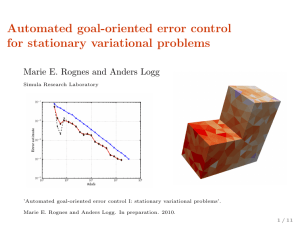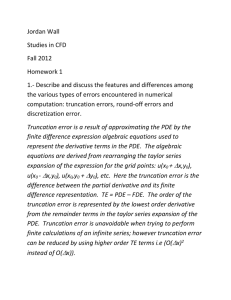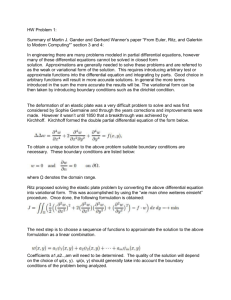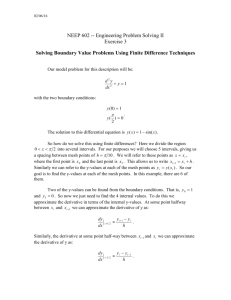Présentation d`un nouveau produit
advertisement
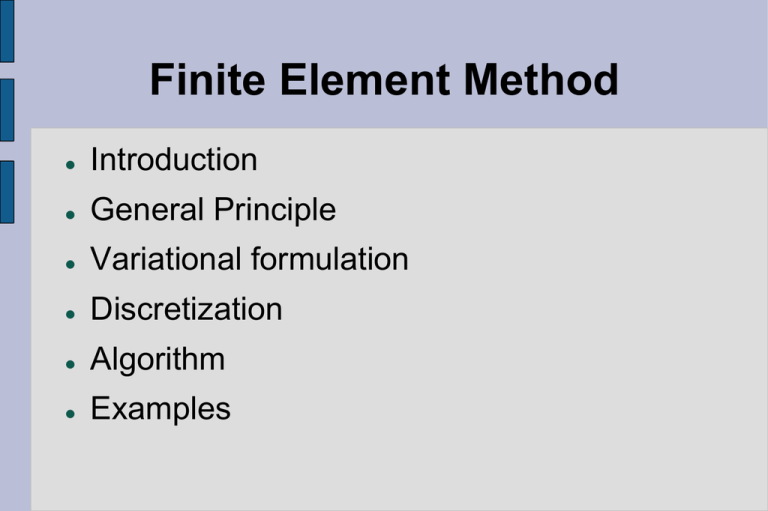
Finite Element Method
Introduction
General Principle
Variational formulation
Discretization
Algorithm
Examples
Introduction
To solve partial differential equations (PDE) we often use the
finite element method. This is a numerical technique which
approximates the solution of a problem that we first have to transform.
This method is frequently used to solve physical problems
because these equations can represent the dynamic behavior of
physical systems.
For example, it can be used to calculate the movement of a
cord shaken by one of its ends or the deformation of a metal
structure.
General Principle
The Finite Element Method consists in finding a discrete mathematic
algorithm allowing to search for an approximate solution of a partial
differential equation (PDE).
Generally this PDE relates to a u function defined on a field and which
has conditions on boundary. We usually call Dirichlet conditions (values on
boundary) and Neumann conditions (gradient on boundary).
Actually we have to solve a problem where, thanks to the variational
formulation, solutions check existing conditions weaker than those of the
starting problem and where discretization allows to find an approximate
solution.
Variational Formulation
Let f be a continuous function on ΩU(δΩ) and u the solution on the
following PDE:
With u checking the Dirichlet's condition: u=0 on δΩ.
Let v a function such that v=0 on δΩ. We transform this equation in:
Using an integration by parts on the first term we find :
− {v d }
k2
¿
¿
¿
¿
¿
¿
¿
¿
¿
¿
¿
{ v u d }= { v f d }
Variational Formulation
We have v=0 on δΩ, so we obtain the weak formulation of the
problem:
If u is twice differentiable there's equivalence between this
formulation and the one of the initial problem. So we will solve the weak
formulation instead of solving the initial problem.
(To have this equivalence we also need to have a field Ω regular
enough and f derivable enough.)
Notations:
So we have:
Discretization
To solve the problem we have to choose a mesh (regular or not) of
the field Ω (to approximate numerically the solution). The more the mesh
will be tightened the more the approximate solution will be close to true.
We also have to take a basis of functions adapted to the mesh. We
often use polynomials of Lagrange. In this basis the function i equals 1 at
the node xi and 0 at other nodes.
In the one-dimensional case it looks like :
Discretization
Let M be a mesh on Ω and b=(e1,...,en) the basis associated.
We're searching for ū the solution of the discretized problem such
as ū=0 on δΩ and for all v function such that v=0 on δΩ:
However in this discretized space, to say that any vector checks
the preceding proposition is equivalent to say that all the vectors of the
basis check the proposition. If we break up the solution in the basis of the
ei we obtain:
If we increase the number of basis functions the solutions un will have to
converge towards the solution u of the PDE.
Algorithm
With the preceding notations we can define:
- the A matrix having for components a(e i ,e j)
- the U vector having for components ui which are the coordinates of the
solution approached on the basis b
- the B vector having for components L(ej)
Then this problem is equal to solving linear equations with n
equations and n unknowns :
AU = B
The matrix A is called matrix of rigidity. It's a symmetric positive definite
matrix. So it's invertible and we have:
U=A-1B
Algorithm
Here the order of the steps of the finite element method:
1. To calculate the matrix of rigidity A
2. To caculate the terms L(ej)
3. To solve AU=B according to the selected level of discretization. U is
given by U=A-1B . The main problem is to choose the best way to
reverse the matrix A because this is the step which needs the most
important computing power.
4. We obtain ū thanks to the vector U which contains the coordinates of
ū on the basis b and then we have an approximate solution of the
problem.
Examples
A physical example of situaton where this problem is encountered
is that of bending of a beam. Here we consider the beam has a length of
1, with x=0 and x=1 as ends, subjected to a linear density of load and
simply supported at its ends.
So the value of the bending moment u(x) at the moment x is
solution of the problem with k2 = 1/EI(x) where E is the Young modulus
of material and I(x) is the principal moment of inertia of the section of the
beam.
Examples
Finite Element Method allows detailed visualization of where
structures bend or twist, and indicates the distribution of stresses and
displacement. That's why it's used in aeronautical or
automotive industries for example.
Digital simulation of a crash test on a car.

